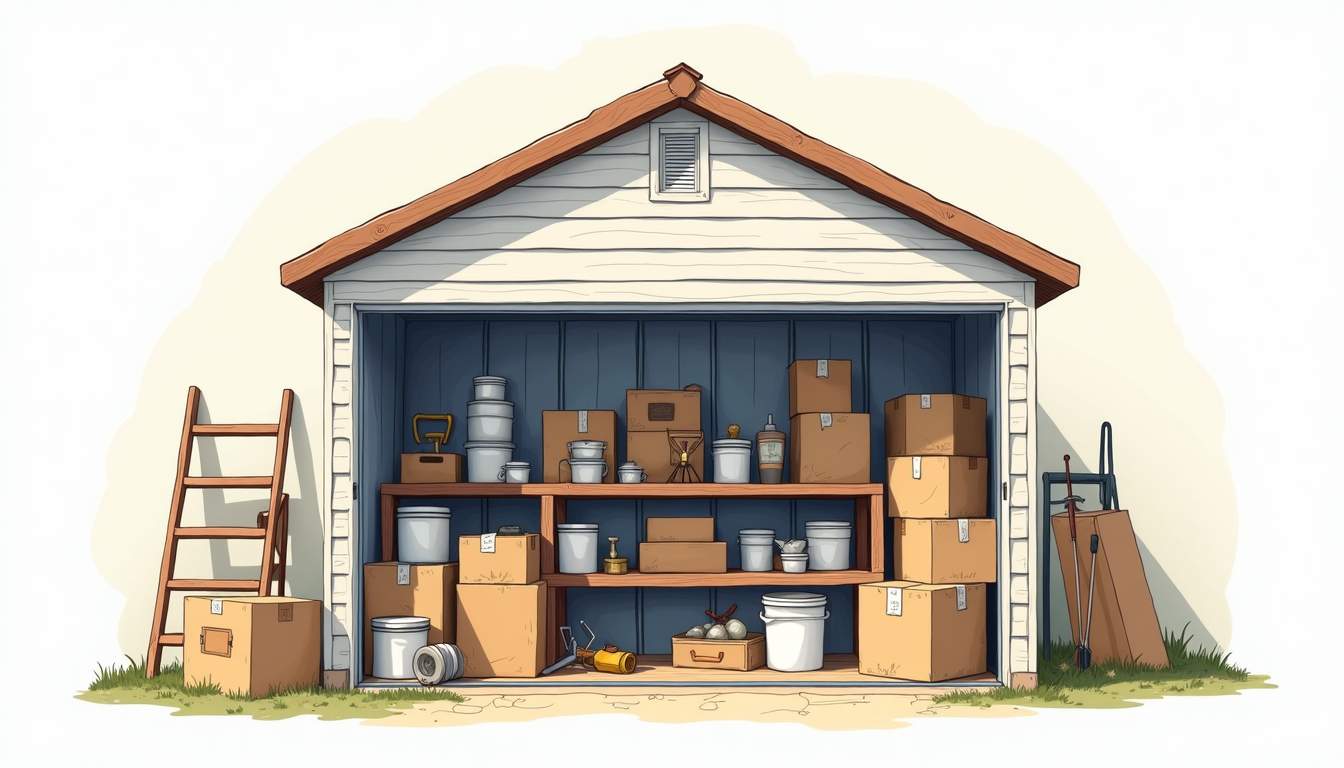
Renovations and delayed move-ins can turn what should be an exciting time into a logistical challenge. Whether you're updating your current home or waiting for your new one to be ready, finding a safe and convenient place to store your belongings is essential. Flexible storage solutions offer the perfect answer, providing security, accessibility, and adaptability to fit your unique timeline and needs.
This article explores a variety of storage options, tips for maximizing space, and practical advice for managing your possessions during these transitional periods. From portable storage units to self-storage facilities, discover how to keep your items safe and organized without adding unnecessary stress.
Understanding the Need for Flexible Storage
Why Renovations and Delayed Move-Ins Require Extra Planning
Renovations often involve clearing out rooms to protect furniture and belongings from dust, debris, and accidental damage. Similarly, delayed move-ins might leave you with possessions but no immediate place to put them. Both scenarios demand thoughtful storage strategies to avoid clutter and keep your items in good condition.
Without proper planning, you might find yourself juggling boxes in cramped spaces, risking damage to valuables, or even losing track of important items. Flexible storage solutions help bridge the gap, offering temporary yet reliable options tailored to your timeline and budget. These solutions can range from portable storage containers that can be delivered directly to your location, to traditional self-storage units that offer various sizes and accessibility options. By evaluating your specific needs, you can choose a storage method that aligns perfectly with your renovation schedule or move-in timeline.
Key Benefits of Flexible Storage
One of the main advantages of flexible storage is the ability to adapt to changing circumstances. Renovations can run longer than expected, and move-in dates can shift due to unforeseen delays. Flexible storage options allow you to extend or shorten rental periods without penalty, giving peace of mind during uncertain times. Furthermore, many facilities provide online management tools, enabling you to adjust your rental terms or access your unit from the comfort of your home, making the entire process more convenient.
Additionally, many storage solutions offer climate control, enhanced security features, and easy access, ensuring your belongings remain safe and in excellent condition. This flexibility can save money and reduce stress compared to more rigid arrangements. Beyond just protection, some facilities also offer packing supplies and moving assistance, which can further streamline your experience. With options like 24-hour access and drive-up units, you can retrieve or store your items at your convenience, making flexible storage not just a practical choice, but a smart one that enhances your overall renovation or moving experience. For reliable services, you can visit Cheap Movers Singapore to explore professional storage and moving solutions tailored to your needs.
Types of Flexible Storage Solutions
Self-Storage Units: Convenience and Variety
Self-storage units are among the most popular options for temporary storage. These facilities typically offer a range of unit sizes, from small lockers to large spaces capable of holding furniture and appliances. Renting a unit is straightforward, with month-to-month contracts that provide flexibility as your renovation or move-in timeline evolves.
Many self-storage facilities provide 24/7 security, surveillance cameras, gated access, and climate-controlled environments. Climate control is particularly beneficial for sensitive items like electronics, artwork, or wooden furniture that could be damaged by humidity or temperature fluctuations. Additionally, many facilities offer convenient online account management, allowing you to pay bills, manage your rental agreement, and even reserve units from the comfort of your home. This level of accessibility and control makes self-storage a hassle-free choice for individuals and businesses alike.
Portable Storage Containers: Storage at Your Doorstep
Portable storage containers combine the benefits of self-storage with the convenience of home delivery. Companies drop off a container at your residence, allowing you to pack your belongings at your own pace. Once loaded, the container can be stored at a secure facility or transported to your new home when you're ready.
This option is especially useful during renovations, as you can keep your belongings close by but out of harm's way. It also eliminates the need for multiple moves, since the container can be moved directly from your old home to your new one. Furthermore, many portable storage companies offer flexible rental terms, enabling you to keep the container for as long as you need, whether it's for a few weeks or several months. This adaptability is particularly appealing for those with unpredictable schedules or extended projects.
Warehouse Storage: Ideal for Large or Specialized Items
If you have large items like pianos, antiques, or bulky furniture, warehouse storage might be the best fit. These facilities often offer specialized storage options, including palletized storage or shelving, to accommodate unique items. Warehouses may also provide additional services such as inventory management and packing assistance.
While warehouse storage is less common for short-term use, it can be a valuable option if you require professional handling or long-term storage beyond the renovation or move-in period. Many warehouses also feature advanced climate control and pest management systems to ensure that your items remain in pristine condition. Additionally, some facilities offer the option to access your items on-site, allowing for easy retrieval without the need for extensive planning or transportation logistics. This makes warehouse storage an excellent choice for businesses needing to store excess inventory or seasonal items, as well as individuals looking for a secure place to keep their prized possessions.
Maximizing Your Storage Space
Smart Packing Techniques
Effective packing is crucial to making the most of your storage space. Use sturdy boxes and label each one clearly with its contents and the room it belongs to. This practice simplifies unpacking and helps prevent lost or misplaced items.

Consider disassembling large furniture pieces to save space and protect them during storage. Wrap delicate items in bubble wrap or blankets, and avoid overpacking boxes to prevent damage.
Organizing for Easy Access
When storing items for renovations or delayed move-ins, it's wise to organize your belongings in a way that allows easy access to essentials. Create an “open first” box containing items you'll need immediately after the renovation or upon moving in, such as basic kitchenware, toiletries, and important documents.
Stack boxes with heavier ones at the bottom and lighter ones on top, and leave pathways if possible to reach items without unpacking everything. Using clear plastic bins can also help you quickly identify contents without opening each container.
Utilizing Vertical Space
Storage units and containers often have high ceilings, so take advantage of vertical space by stacking boxes and using shelving units if allowed. This approach maximizes floor space and keeps your belongings organized.
Be mindful of weight distribution to avoid accidents, and ensure that items placed on top are not fragile or easily damaged.
Tips for Choosing the Right Storage Provider
Assessing Security Measures
Security is paramount when entrusting your belongings to a storage facility. Look for providers that offer gated access, security cameras, on-site personnel, and individual unit alarms. Reading customer reviews can provide insight into the reliability and safety of the facility.
For high-value items, inquire about insurance options or whether your homeowner's insurance covers stored belongings. Some storage companies offer insurance policies tailored to their units.
Evaluating Location and Accessibility
Choosing a storage facility close to your home or renovation site can save time and transportation costs. Consider the facility's hours of operation and whether you'll have 24/7 access if needed. Some providers offer digital access control or online account management, adding convenience to your experience.
For portable storage containers, check the company's delivery and pickup policies, as well as any restrictions on placement at your property.
Comparing Costs and Contract Terms
Storage prices vary based on unit size, location, and amenities. Request quotes from multiple providers and compare what's included. Be wary of hidden fees such as administration charges, deposits, or penalties for early termination.
Flexible month-to-month contracts are ideal for renovations and delayed move-ins, as they allow you to adjust your storage duration without long-term commitments.
Additional Considerations for Stress-Free Storage
Preparing Your Items for Storage
Before storing, clean and dry all items to prevent mold, mildew, and pests. Use moisture absorbers or silica gel packs in boxes to control humidity. For furniture, consider using furniture covers or shrink wrap to protect surfaces.

Remove batteries from electronics to avoid corrosion, and unplug appliances. If storing clothing, use breathable garment bags rather than plastic to prevent fabric damage.
Planning for the Unpacking Process
Having a plan for unpacking can reduce stress once your renovation is complete or your new home is ready. Keep an inventory checklist to track what's in storage and prioritize unpacking based on your daily needs.
Label boxes according to room and content type, and consider color-coding for quick identification. This system will help movers or helpers know exactly where each box belongs.
Communicating with Storage Providers
Maintain clear communication with your storage provider throughout your rental period. Inform them promptly if you need to extend or shorten your contract, or if you encounter any issues accessing your unit. Good communication can prevent misunderstandings and ensure a smooth storage experience.
Additionally, ask about any changes in policies or hours, especially during holidays or unforeseen events.
Conclusion
Renovations and delayed move-ins don't have to disrupt your life or jeopardize your belongings. By choosing flexible storage solutions tailored to your needs, you can protect your possessions, maintain organization, and reduce stress during these transitional periods.

Whether opting for self-storage units, portable containers, or specialized warehouse storage, the key lies in planning, packing smartly, and selecting a provider that offers security, convenience, and adaptable terms. With the right approach, your renovation or move-in experience will be smoother, allowing you to focus on the excitement of creating a new or improved living space.
Investing time in finding the right flexible storage solution is an investment in peace of mind, ensuring your belongings are safe and accessible whenever you need them.





